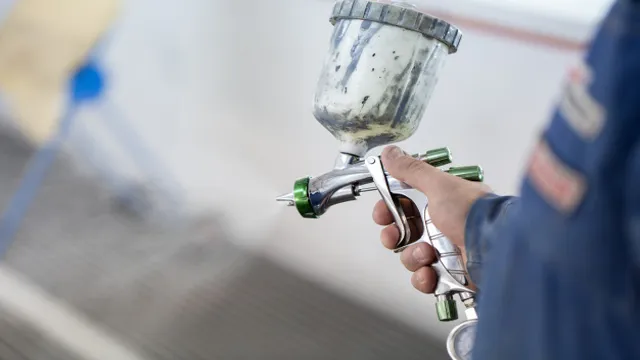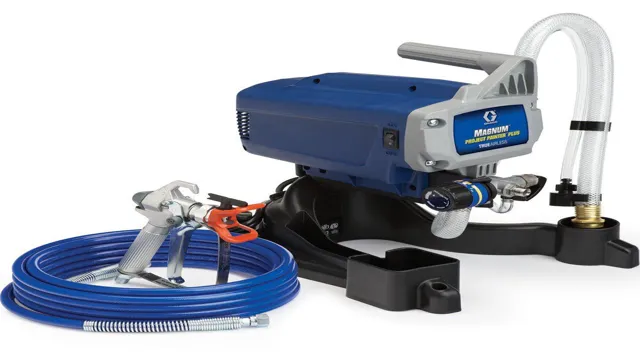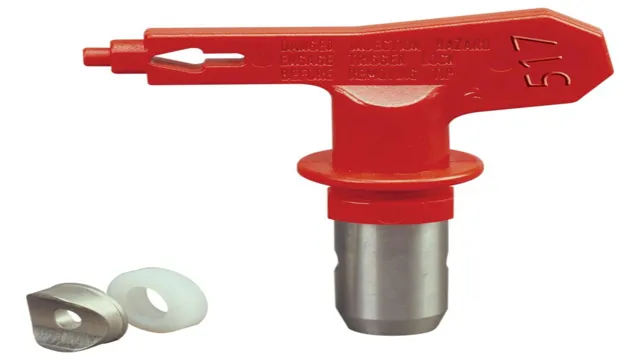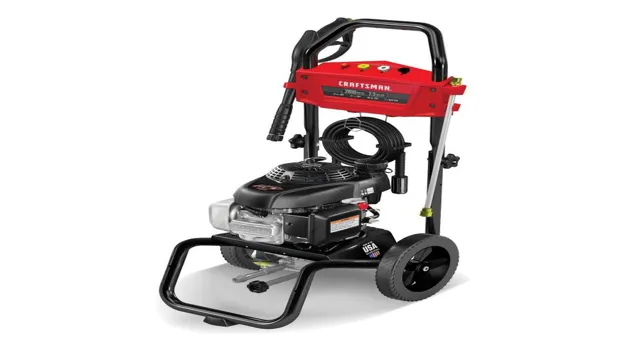What Paint Do You Use in a Paint Sprayer? A Comprehensive Guide to Choosing the Right Paint for Your Project.

Painting a room or a piece of furniture can be a fun and rewarding DIY project, especially when you have the right tools. A paint sprayer can make the job much faster and more efficient than using a traditional brush or roller. However, choosing the right paint for your sprayer can be a bit overwhelming with the plethora of options available on the market.
You want to make sure that you get the right paint for your specific sprayer to ensure that the job is done right and that you don’t waste time and money. In this blog post, we’ll cover what you need to know when choosing the right paint for your paint sprayer.
Types of Paint
When it comes to using a paint sprayer, the most common types of paint to use are latex or oil-based paints. Latex paint is water-based and dries quickly, making it a popular choice for indoor projects. Oil-based paint, on the other hand, takes longer to dry but provides a durable finish that is resistant to chipping and fading.
It is often used for outdoor projects such as fences or decks. Another type of paint that works well with a sprayer is enamel paint. Enamel paint is known for its glossy finish and durability, making it perfect for painting furniture or cabinets.
It’s important to note that when using a paint sprayer, it’s essential to choose a paint that has been thinned to the appropriate consistency for the sprayer. This will ensure that the paint sprays evenly and without clogs or drips. Overall, with the right type of paint and technique, a paint sprayer can make any painting project quicker and easier.
Oil-based Paint
When it comes to types of paint, one popular option is oil-based paint. This type of paint is made by suspending pigment particles in an oil base, usually linseed oil or a synthetic substitute. Although oil-based paint has been around for centuries, it still remains a favorite among professional painters and DIY enthusiasts today.
Oil-based paint is known for its durability and resistance to chipping, making it a great choice for high-traffic areas such as doors, trim, and cabinets. However, it does require solvents for cleaning up, and is not as environmentally friendly as other types of paint. Overall, oil-based paint remains a tried and true option for those looking for a long-lasting finish on their painting projects.

Latex-Based Paint
Latex-based paint is a type of water-based paint that has become increasingly popular in recent years. It is a great option for interior walls and ceilings, as well as exterior surfaces like trim and siding. This type of paint is known for its durability, versatility, and ease of use.
It dries quickly and produces fewer fumes than oil-based paints, making it a safer choice for those with respiratory issues or allergies. Latex-based paint is also easy to clean up with soap and water, which is a major advantage over oil-based paints that require harsh solvents. Overall, if you’re looking for a high-quality paint that is long-lasting and easy to work with, latex-based paint is definitely worth considering.
Acrylic Paint
When it comes to painting, choosing the right type of paint can make all the difference in the finished result. One popular type of paint is acrylic paint, which is known for its fast-drying and water-resistant properties. There are two main types of acrylic paint: artist quality and student quality.
Artist quality acrylics are made with higher quality pigments and have a smoother, more consistent texture. They are also more expensive. Student quality acrylics, on the other hand, are more affordable and are often sold in sets for beginners.
While they may not have the same depth of color or consistency as artist quality acrylics, they are a great option for those just starting out. Ultimately, the type of acrylic paint you choose will depend on your budget, skill level, and the desired outcome of your painting project.
Viscosity of Paint
When it comes to using a paint sprayer, it’s important to choose the right type of paint. The viscosity of paint is crucial in ensuring your sprayer works effectively. Many people wonder, “What paint do you use in a paint sprayer?” Generally, paints with a thinner consistency work best in sprayers because they’re easier to spray and result in a smooth finish.
Look for paints labeled as “sprayable” or “airless-compatible” to ensure the viscosity is suitable for spraying. When selecting paint for your sprayer, it’s also important to consider the type of surface you’ll be painting. Different types of surfaces may require different types of paint, such as latex or oil-based.
Be sure to read the label and follow the manufacturer’s recommendations for the best results. Overall, by choosing the right type of paint and understanding its viscosity, you’ll be on your way to a beautiful, professional-looking paint job.
Thicker Paints for Sprayers
When it comes to using paint sprayers, the viscosity of paint plays a crucial role in achieving the desired results. Thicker paints, for instance, require a higher level of viscosity to prevent clogging and achieve an even coat. As the name implies, viscosity refers to the thickness or fluidity of a liquid, which affects how it spreads and adheres to a surface.
To use thicker paints with a sprayer, it’s essential to choose the right nozzle size and adjust the pressure accordingly for optimal results. Additionally, thinning agents can help reduce the viscosity of thick paint, allowing it to flow more freely and avoid clogs. Ultimately, getting the right viscosity for your paint can be the difference between a smooth, professional finish and a messy, uneven coat.
So, take the time to understand how viscosity works and ensure your sprayer is properly equipped for the type of paint you’re using.
Thinners for Thicker Paints
The viscosity of paint is an essential concept that every painter should understand. The thickness or thinness of paint can impact the final outcome of a project. Thick paints are often preferred for textured finishes, while thinner paints are more suitable for smooth finishes.
When working with thicker paints, it’s important to use paint thinners to achieve the desired consistency. While thinners for thicker paints are not a one-size-fits-all solution, they do help in breaking down the pigment and binder particles that create the thicker consistency. This process enables the paint to flow more easily from the brush and onto the surface.
It’s important to add the thinners in small increments, testing the consistency as you go because thinning the paint too much can reduce its quality. Understanding the viscosity of paint and the use of thinners for thicker paints can help you achieve the perfect finish for your project.
Sprayer Compatibility
When it comes to painting with a sprayer, the type of paint you use is crucial to ensure proper functionality and optimal results. So, what paint do you use in a paint sprayer? First, consider the compatibility of the paint with the sprayer you are using. Some paint sprayers work better with specific types of paint, such as latex or oil-based paints.
It’s essential to check the manufacturer’s instructions or consult with a professional before selecting the type of paint to use. Additionally, the viscosity of the paint is also critical. Most paint sprayers have a recommended range of viscosity, and exceeding it can lead to clogs and other issues.
Ultimately, choosing the right paint for your sprayer can make all the difference in achieving a professional-looking finish.
Check Manufacturer Recommendations
As a responsible buyer, it’s essential to check the manufacturer recommendations before selecting a sprayer. Knowing the compatibility between your sprayer and the product you plan to spray is crucial for ensuring optimal performance and avoiding any potential damage. For instance, some herbicides or pesticides may require a specific type of sprayer, such as a backpack sprayer or a high-pressure sprayer.
Similarly, the material of the sprayer, such as plastic or metal, can also impact the product’s effectiveness. Overall, understanding the sprayer’s compatibility can help you make an informed decision and get the best results for your application. So always be sure to read through the manufacturer’s recommendations carefully before making a purchase.
By doing so, you can save time, money, and avoid the risks of using an incompatible sprayer.
Test a Small Area First
When it comes to spraying chemicals, it’s important to test a small area first to ensure that your sprayer is compatible with the chemicals you plan to use. This will help you avoid any potential damage to your crops or unintended effects on the environment. Sprayer compatibility is an important consideration, as not all sprayers are created equal.
Some may be better suited for certain types of chemicals or at certain application rates, so it’s important to choose the right equipment for the job. By testing a small area first, you can ensure that your sprayer is working properly and effectively, giving you the best possible results in your overall crop management efforts. So, before you start spraying, take the time to test a small area first and make sure that your sprayer is compatible with the chemicals you plan to use.
Summary
When it comes to using a paint sprayer, one of the most common questions people have is what type of paint to use. The good news is that most paint sprayers can handle a variety of paint types, including latex paints, oil-based paints, and even stains. However, it’s important to choose the right paint for your project to ensure a smooth finish.
Latex paint is a popular choice for indoor projects as it dries quickly and is easy to clean up with water. Oil-based paints are best for outdoor projects such as decks and fences as they are more durable and can withstand harsh weather conditions. Stains are perfect for wooden surfaces and provide a natural-looking finish.
In any case, it’s important to follow the manufacturer’s instructions and use the appropriate paint thinner for your sprayer to achieve a professional-looking result. Ultimately, the type of paint you choose will depend on your personal preference and the specific needs of your project.
Conclusion
In conclusion, the paint you use in a paint sprayer is kind of like choosing the right wine for a fancy dinner party. It all depends on the type of surface you’re painting, the texture you’re going for, and the overall aesthetic you want to achieve. So, whether you’re a fan of bold acrylics or subtle latex blends, the right paint for your sprayer is out there waiting for you.
Just remember to do your research, test it out, and let your creative juices flow!”
FAQs
What type of paint can be used in a paint sprayer?
Paint sprayers can be used with a variety of paint types including acrylic, latex, enamel, and oil-based paints.
Can water-based paint be used in a paint sprayer?
Yes, water-based paints such as latex can be used in a paint sprayer. In fact, they are the most commonly used paint type in sprayers.
Is it necessary to thin the paint before using it in a sprayer?
Yes, depending on the viscosity of the paint and the type of sprayer being used, paint may need to be thinned with water or a specific paint thinner before use.
Are there specific types of sprayers for specific types of paints?
Yes, some sprayers are designed for specific paint types such as airless sprayers for thick coatings or HVLP (high volume, low pressure) sprayers for finer finishes like furniture.
Can oil-based paints be used in a sprayer?
Yes, oil-based paints can be used in a paint sprayer. However, they require more cleanup and can produce more overspray than some other types of paint.
What kind of nozzle should be used for spraying paint?
The size of the nozzle chosen depends on the type of paint being used, the surface being painted, and the desired finish. Generally, larger nozzles are used for thicker coatings and smaller nozzles for finer finishes.
How should the paint sprayer be cleaned after use?
The paint sprayer should be cleaned thoroughly after each use to prevent buildup or clogs. This typically involves flushing the sprayer with a cleaning solution or water and wiping down the components.






